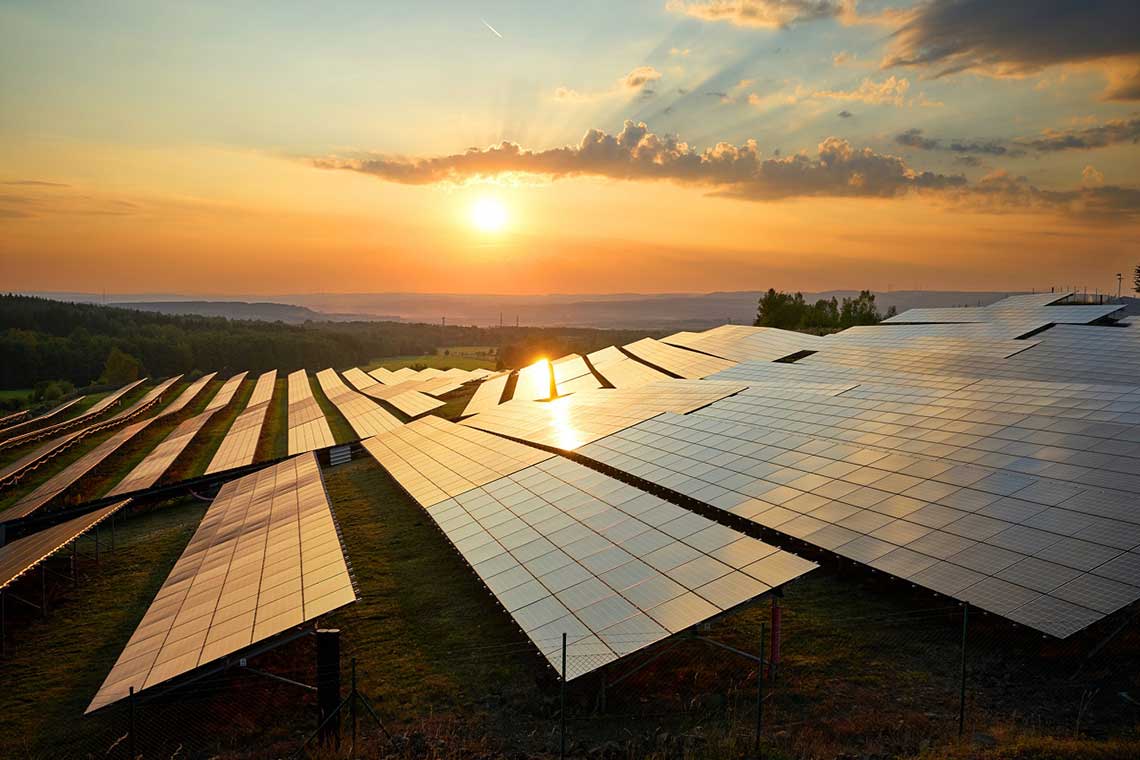
Investigation Debunks Claims about Solar Panels Taking Up Farming Land in the UK

Ground-mounted solar takes up 0.1% of land in the UK, says Carbon Brief. Image: Getty Images.
Introduction
An investigation by Carbon Brief has dispelled claims made by Liz Truss and her opponent Rishi Sunak that solar is taking up precious farming land in the UK with it amounting to just 0.1% of UK land.
Background
Amid the Conservative leadership race, Truss and Sunak have continuously argued that land should be used for crops, instead of solar panels.
Truss even went on to state at a recent husting in Darlington that she is “somebody who wants to see farmers producing food, not filling in forms, not doing red tape, not filling fields with paraphernalia like solar farms.”
Evidence and Analysis
According to Solar Energy UK, for every megawatt of power, six acres of land is necessary for current projects. With this, current ground-mounted solar covers an estimated 230 square kilometres (km2), said Carbon Brief. This takes up just 0.1% of land in the UK.
Government plans to scale up solar in line with its net zero targets are expected to bring this up to just 0.3% of the UK land area. This is the equivalent to around 0.5% of the land currently used for farming – and roughly half of the space taken up by golf courses, said Carbon Brief.
Carbon Brief also said that, in comparison, according to Corine Land Cover data, agricultural land covers 56% of the UK. With Truss deliberately targeting the agricultural industry to raise concerns around solar taking up farming land, these allegations are made on false grounds.
Benefits of Ground-Mounted Solar
Another key benefit is the use of ground-mounted solar that has a capacity of 9.6GW in the UK. Using ground-mounted solar can be placed on farmlands that currently cannot be used for growing produce or crops mainly due to gradual wear and tear on the landscape.
Implementing ground-mounted solar can provide a means for the ground to increase its fertility yet again whilst generating key energy required for the energy transition. This is becoming increasingly important amid the ongoing energy crisis being affected by high wholesale gas prices worldwide.
Sustainable Development Goals (SDGs)
As part of plans to dramatically scale the solar industry in the UK, the government has outlined plans to increase capacity up to five times by 2035.
The strategy had been produced in response to increasing uncertainty in the energy sector, on the back of high gas prices throughout 2021 and into the beginning of this year, as well as increased volatility over the past month in response to the Russian invasion of Ukraine.
Carbon Brief commented this would involve increasing ground-mounted solar capacity by an additional 38GW. As solar technology becomes more efficient it will require less space meaning that, assuming an average of three acres per 1MW, if the government meets its target of increasing solar capacity fivefold, ground-mounted solar could cover a total of almost 700km2 by 2035. This equates to nearly 0.3% of the UK’s land surface.
This is a small figure given the current land use in the UK and thus debunks claims made by both Sunak and Truss that solar panels will take up vast amounts of agricultural land in the UK.
SDGs, Targets, and Indicators
1. Which SDGs are addressed or connected to the issues highlighted in the article?
- SDG 7: Affordable and Clean Energy
- SDG 11: Sustainable Cities and Communities
- SDG 13: Climate Action
- SDG 15: Life on Land
2. What specific targets under those SDGs can be identified based on the article’s content?
- SDG 7.2: Increase substantially the share of renewable energy in the global energy mix.
- SDG 11.4: Strengthen efforts to protect and safeguard the world’s cultural and natural heritage.
- SDG 13.2: Integrate climate change measures into national policies, strategies, and planning.
- SDG 15.3: By 2030, combat desertification, restore degraded land and soil, including land affected by desertification, drought, and floods, and strive to achieve a land degradation-neutral world.
3. Are there any indicators mentioned or implied in the article that can be used to measure progress towards the identified targets?
- Percentage of land in the UK covered by ground-mounted solar panels.
- Current and projected capacity of ground-mounted solar in the UK.
- Comparison of land used for ground-mounted solar with land used for agriculture and other purposes.
4. Table: SDGs, Targets, and Indicators
| SDGs | Targets | Indicators |
|---|---|---|
| SDG 7: Affordable and Clean Energy | Increase substantially the share of renewable energy in the global energy mix. | Percentage of land in the UK covered by ground-mounted solar panels. |
| SDG 11: Sustainable Cities and Communities | Strengthen efforts to protect and safeguard the world’s cultural and natural heritage. | Current and projected capacity of ground-mounted solar in the UK. |
| SDG 13: Climate Action | Integrate climate change measures into national policies, strategies, and planning. | Comparison of land used for ground-mounted solar with land used for agriculture and other purposes. |
| SDG 15: Life on Land | By 2030, combat desertification, restore degraded land and soil, including land affected by desertification, drought, and floods, and strive to achieve a land degradation-neutral world. | Comparison of land used for ground-mounted solar with land affected by desertification, drought, and floods. |
Based on the article, the issues discussed are connected to several Sustainable Development Goals (SDGs). SDG 7 (Affordable and Clean Energy) is addressed as the article highlights the use of ground-mounted solar panels to generate clean energy. SDG 11 (Sustainable Cities and Communities) is connected as the article mentions the need to protect and safeguard natural heritage while implementing solar projects. SDG 13 (Climate Action) is relevant as the article emphasizes the integration of climate change measures in national policies and strategies. Finally, SDG 15 (Life on Land) is addressed as the article discusses the potential of ground-mounted solar to combat desertification and restore degraded land.
Specific targets under these SDGs can be identified based on the article’s content. For SDG 7, the target is to increase substantially the share of renewable energy in the global energy mix. For SDG 11, the target is to strengthen efforts to protect and safeguard the world’s cultural and natural heritage. For SDG 13, the target is to integrate climate change measures into national policies, strategies, and planning. And for SDG 15, the target is to combat desertification, restore degraded land and soil, and strive for a land degradation-neutral world by 2030.
The article mentions or implies several indicators that can be used to measure progress towards the identified targets. The percentage of land in the UK covered by ground-mounted solar panels can be used as an indicator for SDG 7. The current and projected capacity of ground-mounted solar in the UK can serve as an indicator for SDG 11. The comparison of land used for ground-mounted solar with land used for agriculture and other purposes can be an indicator for both SDG 13 and SDG 15.
Behold! This splendid article springs forth from the wellspring of knowledge, shaped by a wondrous proprietary AI technology that delved into a vast ocean of data, illuminating the path towards the Sustainable Development Goals. Remember that all rights are reserved by SDG Investors LLC, empowering us to champion progress together.
Source: solarpowerportal.co.uk

Join us, as fellow seekers of change, on a transformative journey at https://sdgtalks.ai/welcome, where you can become a member and actively contribute to shaping a brighter future.





